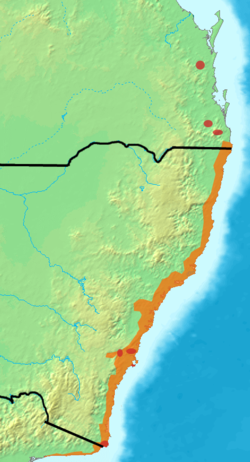| Eastern bristlebird | |
|---|---|
 | |
| Scientific classification | |
| Kingdom: | Animalia |
| Phylum: | Chordata |
| Class: | Aves |
| Order: | Passeriformes |
| Family: | Dasyornithidae |
| Genus: | Dasyornis |
| Species: | D. brachypterus |
| Binomial name | |
| Dasyornis brachypterus (Latham, 1801) | |
 | |
| Distribution of the eastern bristlebird (2010) Orange indicates possible range | |
The eastern bristlebird (Dasyornis brachypterus) is a species of bird in the bristlebird family, Dasyornithidae. It is endemic to Australia. Its natural habitats are temperate forests, temperate shrubland, and temperate grassland. It is threatened by habitat loss.
